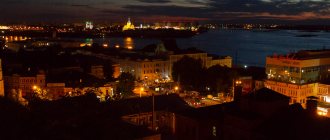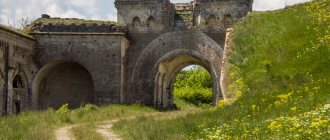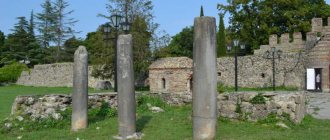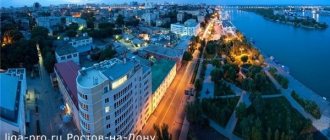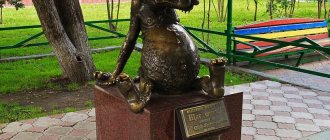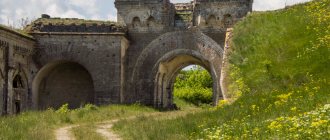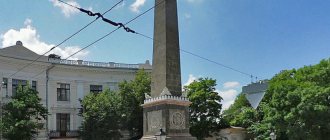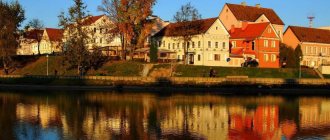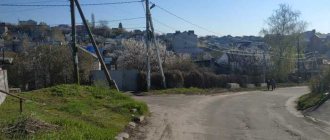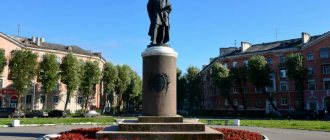There are countless unique cities in Russia, but even against this colorful background, Norilsk stands out, bearing the title of the northernmost city in the world. It was built in the middle of the last century in the vastness of the subarctic, where in the summer the sun does not set for almost two months, and in the winter the polar night lasts 45 days. At the same time, Norilsk is by no means a large settlement for shift workers, but a full-fledged and self-sufficient city with a population of about 180 thousand people. In terms of the number of residents, by the way, in the Krasnoyarsk Territory it is second only to the titular metropolis. Everything is being done here to ensure that the workers of the grandiose metallurgical enterprise and their families feel as comfortable as possible in the Arctic, without feeling isolated from the “mainland”. The infrastructure provision of Norilsk can be the envy of many cities in Siberia, the Central and Western regions of the Russian Federation. Recently, the tourism potential of the policy has begun to unfold. Travelers who prefer to have an active holiday and crave exotic things come here. In the vicinity of the city, for example, there is a modern ski center. Hunting, fishing, and tundra tours organized by local operators are very popular. The sights of Norilsk are also of significant interest to vacationers, photos and descriptions of which can be found in the article.
The main attractions of Norilsk: TOP-5
What should you see first in Norilsk? Of course, to architectural, historical and miraculous objects that claim to be the calling cards of the capital of the Russian Arctic!
Gvardeyskaya Square
- Address: historical center of Norilsk. Transport stop "Yenisei Store" or "Talnakh Department Store".
The rating of Norilsk sights opens with the main square of the city - the majestic creation of Soviet architects, who brilliantly implemented the project of architects L. Minenko and V. Nepokoichitsky. The urban planning ensemble, which was finally formed in the late 60s of the 20th century, looks solemn. The recreation, which has a diameter of 90 m, is framed by semicircular six-story buildings with luxurious arcades and colonnades. Between these buildings, separated by passages, is the mansion of the NMMC Administration. Particularly impressive is the harmony of the architectural composition, in which there is nothing superfluous.
First house
- Address: Leninsky Prospekt, 14. Transport stop "Restaurant Lama".
The inclusion of a nondescript wooden house in the TOP attractions of Norilsk will seem random only at first glance. In fact, every log of this mansion is imbued with symbolism. Still would! It is the only one of the first buildings erected on the territory of the subarctic city that has survived to this day. It was under the roof of a plank hut that the participants of N. Urvantsev’s expedition spent the winter, which discovered a rich deposit of coal and minerals containing sulfides in the vicinity of Mount Rudnaya. The buildings of the hostel, warehouses, and bathhouses were eventually demolished, but the house remained. Now it has been turned into a museum.
Calvary
- Address: Mount Schmidt. Transport stop "Torgmontazh".
The history of Norilsk is not only a series of high-profile labor victories and heroic achievements. There is also an extremely dark page in it. A huge number of prisoners of the notorious Gulag unit, through which almost 500 thousand people passed through during the years of Stalin’s terror, were involved in the construction of the plant and the first city blocks. Many of the prisoners were no longer destined to return home from the harsh Arctic. The memorial complex “Norilsk Golgotha” was erected in memory of the victims of repression who served time in Noril’LAG and died from disease, malnutrition, exhausting labor in inhumane conditions, and the arbitrariness of guards. The composition consists of several objects, the appearance of which clearly reveals features inherent in several architectural schools at once. This was originally intended, because the Gulag crushed human lives, regardless of the nationality of the prisoners. This is a monument to all the victims of the Yezhov-Beri Baal - Russians, Poles, Latvians, Ukrainians, Jews, Estonians.
Norilsk Mining and Metallurgical Combine
- Address: st. Nansen, 5. Transport stop “Zub-mountain”.
The city-forming enterprise is the basic structure of the Norilsk Nickel holding, and is rightfully considered the flagship of the Russian non-ferrous metallurgy. NGM leads the ranking of world producers of palladium and nickel, and is one of the Big Five enterprises supplying the global market with platinum and rhodium. The industrial giant, built by Gulag prisoners and volunteers of the labor army of the Soviet Union, provides work for almost half of the townspeople. The enterprise is included in the register of sensitive facilities, so it is not easy to get a tour of the plant’s workshops. Adherents of industrial tourism should contact the company’s press service on this issue, located in building No. 2 on Gvardeyskaya Square.
Putorana Nature Reserve
- Office hours: daily, from 9:00 to 18:00.
- Telephone.
- Website: https://platoputorana.ru
- Address: st. Talnakhskaya, 22. Transport stop “Anisimova Street”.
The unique natural recreation is the main non-man-made attraction of Norilsk, recognized by UNESCO as part of the World Natural Heritage of Humanity. The vast territory of the reserve covers almost 1900 hectares of taiga, forest-tundra, desert-arctic areas located in the North-West of the Central Siberian Plateau. There are a lot of picturesque ancient lakes of tectonic origin and amazing waterfalls in the conservation area. The height of the peaks of the mountain plateaus in some places reaches 1500 m. The nature here is pristine, and the ecosystems are almost pristine. This is a real Mecca for lovers of extreme travel. The administration of the reserve invites tourists to take part in hiking, water, and ski trips of varying difficulty levels. You will be left with many vivid impressions from an exotic safari.
Geographical location and history of Norilsk
Norilsk is located in the north of the Krasnoyarsk Territory and is the administrative center of the district.
After Krasnoyarsk, the city ranks second in population, despite the fact that it is located in a harsh climatic zone and has the status of the northernmost city.
Figure 1. Norilsk. Author24 - online exchange of student work
Note 1
The city is closed to foreign tourists; they need special permission to enter it. Similar measures were taken in 2001, although from 1991 until this date Norilsk was open to the public.
Are you an expert in this subject area? We invite you to become the author of the Directory Working Conditions
The city territory includes several districts - Central District, Talnakh, Kayerkan, Oganer, Snezhnogorsk, which differ from each other.
The Central District was built first, others later.
The city received its name based on its geographical location - along the nearby Norilka River, and it itself is located near the Norilsk Mountains.
Note 2
The region is a zone of continuous distribution of permafrost rocks, the thickness of which is 40-80 m. This is one of the coldest cities in the world. It is much colder than Murmansk, despite the fact that it is located almost at the same latitude.
Norilsk is located 300 km north of the Arctic Circle, 2,400 km from the North Pole, and 1,500 km from the capital of the Krasnoyarsk Territory.
The geographical location of the city is inconvenient and leads to various problems, one of which is transport accessibility.
There is no land connection with other cities, with the exception of the port of Dudinka.
Finished works on a similar topic
Course work Climatic conditions of Norilsk 420 ₽ Abstract Climatic conditions of Norilsk 260 ₽ Test paper Climatic conditions of Norilsk 220 ₽
Receive completed work or specialist advice on your educational project Find out the cost
Passenger and cargo traffic, if navigation along the Yenisei is closed, is transported by plane from Alykel airport.
The second very acute problem is the high pollution of the atmosphere, into which enterprises annually emit large amounts of sulfur dioxide, phenols, and heavy metal particles.
Norilsk is on the list of the dirtiest cities on the planet. For air poisoning in Canada, Norilsk enterprises pay compensation to her.
The first expedition to this area was made by a group of geologists led by N. Urvantsev in 1920 to study the deposits of the territory.
During the second expedition, in 1921, the first wooden house was built at the foot of the mountain, and already in 1939 Norilsk became a workers' village.
It received city status in 1953. The city was built by political prisoners of the Gulag system, most of whom remained here, considering the city their second homeland.
By this time, the following were built in the city:
- hospitals,
- schools,
- clubs,
- cinema,
- stadium.
Architecture and monuments of Norilsk
The main architectural attractions of Norilsk are considered to be colorful buildings erected in the solemn Stalinist style. In addition, the city has several interesting monumental creations - a wonderful setting for selfies.
Oktyabrskaya Square
- Address: Leninsky Prospekt. Transport stop "School No. 1".
Like the capital St. Petersburg , polar Norilsk was built strictly according to plan. The only difference is that the author of the development project for Northern Palmyra is considered to be the first Russian emperor, and the policy in the subarctic is considered to be a group of talented Soviet architects. According to their plan, the main transport artery of Norilsk, Lenin Avenue, should consistently open up several spacious beautiful squares with branches of secondary streets. The first of these recreations was called Oktyabrskaya. The entrance to the square is guarded by two symmetrical pompous towers above the corner mansions. There are luxurious arches in the wings of the buildings, reminiscent of the St. Petersburg counterparts in the General Staff building. The architectural ensemble looks great.
Monument “Girl Geologist”
- Address: st. Oktyabrskaya. Transport stop "School No. 1".
The history of the most romantic monument in Norilsk is very interesting. The first plaster statue of a girl geologist appeared in the city at the dawn of its existence. However, the short-lived material did not stand the test of winds and frosts. Over time, the fragile plaster began to crumble from the metal frame and the statue collapsed. But not everyone has forgotten about her. The management of the metallurgical plant found a means to create a new monument, now made of bronze. Soon the sculpture was cast and installed in its original place, and the hill around it was improved. Now local guides always take tourist groups to the monument. Moreover, a trip to a geologist girl with photography against the backdrop of an art object has become an obligatory part of the wedding ritual of Norilsk newlyweds.
Palace of Culture of the Metallurgical Plant
- Address: Leninsky Prospekt, 9. Transport stop "Restaurant Lama".
The last building in Norilsk, erected during the era of the triumph of pompous Stalinist architecture, is the Palace of Culture of Metallurgists. The monumental structure, for all its massiveness, looks very elegant. A similar effect is achieved due to the large glazing area of the facade. At the same time, the tiers of windows are recessed relative to the front line between high concrete partitions. Using an original solution, the architects managed to significantly reduce the wind load on the glazed openings. The building has been in use for over 50 years and continues to be in very good condition.
Memorial composition “Black Tulip”
- Address: Komsomolsky Park. Transport stop "City Park".
The Afghan War, the last major international conflict involving a socialist superpower at the end of its power, claimed the lives of thousands of soldiers of the Soviet army. Among them there were many Norilsk residents. In memory of the feat of the heroes who honestly fulfilled their international duty, a monument was erected on the territory of the Komsomolsky Park of the city. Between the concrete arches towering above the horizontal installation of the Order of St. Andrew the First-Called, a black stone flower is placed - a symbol of the AN-12 aircraft with a load of 200 on board. The sculptural composition of L. Shaidullina penetrates to the depths of the soul.
Monument to the chair
- Address: Leninsky Prospekt. Transport stop "Restaurant Lama".
There is one unusual art object in Norilsk, which the townspeople have ambivalent attitudes towards. This is a monument to a chair created by local artist O. Osmuk. Although the statue does not shine with particular sophistication, every tourist visiting the city considers it a duty to take a photo against its background. There is a version that in the original the composition consisted of two figures. The artistic addition to the piece of furniture was supposedly also a toilet. However, the city authorities categorically refused to consider the embodiment of the plumbing device a work of art and eliminated the “unethical” part of the monument.
Enterprises of Norilsk and the city-forming sphere of activity
About half of the city's residents work at mills and factories that are part of. It includes the Nadezhdinsky Metallurgical Plant, as well as copper and nickel plants. The company is a mining and metallurgical company. This is the main complex around which all the city's activities are built. It is not for nothing that it is called a “calling card”, although visits, as we have already said, are limited here.
But the location of the enterprise is not entirely favorable. Wind from any direction brings sulfur, phenol and heavy metals directly into the city. Acid rain is not uncommon here, and houses are covered in industrial dust. The waste here exceeds the emissions of Western European countries combined. For example, about 2.4 million tons of sulfur antigrid evaporate into the air when working with Talkhan ores.
This amount of waste significantly pollutes the environment and affects public health. 10 MPC is a fairly significant figure showing the content of sulfur dioxide in the air. And although carbon dioxide from Norilsk CO2 emissions is 2%, there is severe water pollution in this area. Some emissions simply end up in lakes, and the rivers have long since lost their former living creatures.
Despite so much dirt in the air, smog is not typical for Norilsk. The wind blowing from the north carries all the dust outside the city. It also settles there, but is not carried into the Arctic Ocean. Instead of water, the tundra and forest-tundra are polluted, and an incredible amount of emissions are absorbed by the soil. It is prohibited to pick berries and mushrooms in Norilsk; they contain dangerous amounts of copper and cadmium. In addition, people cannot drink tap water because it is unfit for consumption. According to environmentalists, the city's pollution has long exceeded all limits.
Theaters and museums of Norilsk
The inhabitants of the amazing polar city have no problems satisfying their cultural needs. Among the places where travelers can go in Norilsk who want to replenish their knowledge or get vivid impressions, city museums and the theater stand out.
Art Gallery
- Opening hours: Tuesday – Sunday, from 11:00 to 19:00.
- Ticket price: adult 100 rubles, children 50 rubles.
- Telephone.
- Address: st. Talnakhskaya, 78. Transport stop “Ploshchad Gazovikov”.
The Norilsk Vernissage will delight visiting art fans with a wonderful collection of works by domestic masters of painting and graphics of the second half of the last century. The collection, in particular, presents works by national artists of Russia V. Efanov, A. Gritsai, P. Ossovsky, E. Kibrik. A real discovery for visitors will be the colorful paintings of Taimyr painters N. Sviridov, E. Goncharova, G. Knyazhevsky, who are not very well known outside the region. The gallery's funds, established in 1973, are constantly replenished. Today they contain more than 5.5 thousand works of art, most of which are displayed in permanent exhibition.
Museum of the History of the Norilsk Industrial District
- Opening hours: from Tuesday to Sunday inclusive, from 11:00 to 19:00, on Fridays from 13:00 to 21:00.
- Ticket price: adult 100 rubles, children 50 rubles.
- Telephone.
- Website: https://norilskmuseum.ru
- Address: Leninsky Prospekt, 14. Transport stop "Museum".
The oldest cultural and educational institution in Norilsk celebrated its 80th anniversary in 2019. The museum's exhibitions are housed in the halls of a picturesque mansion built in the middle of the last century, under whose roof the largest city cinema once operated. It will be interesting to visit here for both adults and young tourists. During the excursion, curious travelers will be able to familiarize themselves with unique documents telling about the first stages of the development of the Russian Arctic, the construction of Norilsk, and the history of the notorious NKVD camp. In addition, the museum has interesting collections of minerals, archaeological and paleontological artifacts. The halls of the ethnographic section of the exhibition, telling about the culture and life of the indigenous inhabitants of Taimyr, are very impressive.
Polar Drama Theater
- Opening hours: performances are given from Thursday to Sunday inclusive. Evening performances start at 18:00 or 19:00, daytime performances at 15:00.
- Ticket price: from 250 rub. up to 600 rub.
- Telephone.
- Website: https://northdrama.ru
- Address: Leninsky Prospekt, 34. Transport stop "Family Center".
The history of the northernmost drama theater in the world is amazing. It was created so that the heroic workers who extracted the mineral resources necessary for the country in the harsh subarctic did not feel isolated from the “mainland” and did not feel cultural “hunger.” In the era of Stalinist repressions, the constellation of talents playing on the Norilsk stage could be the envy of the best theaters of the USSR. In front of local spectators, such stars of Russian cinema as I. Smoktunovsky, G. Zhzhenov, E. Urusova, and artists of the Lvov choir, who were interned in full at NorilLag, performed in front of local audiences. By the way, successful creative activity in the theater helped many artists escape early from the “embraces” of the NKVD. In those harsh years, impressive stage traditions of polar drama were laid, which subsequent generations of actors tried their best to maintain. Today the theater is considered one of the best in the Krasnoyarsk Territory, constantly tours the country, and regularly takes part in reputable festivals.
Climate and nature of Norilsk
Due to the very harsh winter and windy weather, Norilsk received the status of the coldest city.
Snowstorms and severe frosts of more than 38 degrees continue here for almost nine months of the year, and the strongest winds do not stop for six months. Summer is cool and short, the average temperature of the “hot” period is 13 °C. Colorful houses
There are no parks or squares in Norilsk, no trees grow here at all! In order to somehow add life and joy, the first multi-storey buildings in the city were painted in different colors: a blue house, a pink one next to it, a greenish one next to it. And the whole avenue looks like a rainbow, although not very bright, but pastel, gentle.
Norilsk churches
As you know, there were many clergymen among the Gulag prisoners. They, secretly from the camp administration, confessed and gave communion to prisoners seeking to find peace in faith. However, there was no talk of official services then. Accordingly, there were no religious buildings in the city. The situation changed radically at the turn of the century. Already in modern times, temples of the main religious denominations appeared here.
Cathedral in the name of the icon “Joy of All Who Sorrow”
- Opening hours: daily, from 8:00 to 20:00.
- Telephone.
- Website: https://norilsk-eparhia.cerkov.ru
- Address: st. Pushkina, 11. Transport stop "Temple".
The first service under the arches of the main city church, consecrated in the name of the revered Orthodox relic, took place in 1997. However, it took another 6 years to complete the construction of the cathedral. But this time was not wasted. The church is truly impressive. The heavenly blue of its starry domes is set off by the blackened roof of the tent under the main gilded onion. The turquoise color of the facade is in harmony with the whiteness of the arches and columns. The cathedral exudes lightness, calm, and peace. By the way, the place for the construction of the temple was not chosen by chance. The cathedral was erected over the ruins of the barracks of Norillag, which crushed tens of thousands of human destinies.
Trinity Church
- Opening hours: daily, from 7:00 to 19:00.
- Telephone.
- Website: https://talnah-hram.cerkov.ru
- Address: st. Stroiteley, 13A. Transport stop "Shopping Center".
Half an hour’s drive from Norilsk is the village of Talnakh, where it’s worth a trip just to admire the amazing temple. The elegant building seems to be a revived illustration for books on the ancient history of Rus'. This is exactly what the churches of the distant ancestors of today's Russians, who lived in the Middle Ages near Smolensk , Tver or Pskov . The temple is colorful not only from the outside. Under its roof one can feel an atmosphere of special splendor created by the harmonious combination of discreet surroundings, the natural warmth of wood, which prevails in the decoration of walls and vaults with the solemnity of the images of the iconostasis.
Noord-Kamal Mosque
- Opening hours: daily, from 8:00 to 22:00.
- Telephone.
- Address: st. 50 years of October, 2. Transport stop “School No. 1”.
The only Muslim temple in the city, which opened its doors to believers in the fall of 1988, has every reason to be considered an iconic landmark of Norilsk. Firstly, it is the northernmost mosque ever built on the planet. The validity of this statement is confirmed by the corresponding entry in the Guinness Book of Records. Secondly, Nurd-Kamal’s appearance is somewhat different from the standards of Islamic religious architecture. The minaret of the temple, rising 30 meters above the ground, has the shape of a tetrahedral obelisk, rather than the classic round tower. The unconventional configuration makes the structure more resistant to strong winds and dense snowstorms - a common phenomenon for Norilsk in winter.
Where to go with children in Norilsk
A trip to the polar city will, without a doubt, become a highlight in the life of a young traveler. A safari in the picturesque surroundings of Norilsk, for example, will allow a child to enjoy the charm of the unique nature of the Subarctic. And here you can visit the northernmost water park in Russia.
Red stones
- Address: outskirts of Talnakh. Transport stop "Talnakh Bus Station".
Just 30 km from the city there is a picturesque gorge - a favorite vacation spot for Norilsk residents, where you can have great fun with the whole family. It runs in an intricate line between the two peaks of the Kharaelakh mountain range. The canyon walls are incredibly picturesque. They surround a small lake with crystal clear water. The reservoir is filled from a river, two cascades of streams falling from the top of a rock. The depth of the lake, by the way, reaches 9 m in places. The gorge got its name from the color of the rock. The stones here have a distinct red-brown tint. This makes the surroundings somewhat reminiscent of Martian panoramas. The canyon walls have complex terrain. For beginners and experienced climbers, this is a real haven.
Waterpark "Tropicana"
- Working hours: from Thursday to Monday inclusive. On weekends from 10:00 to 22:00, on weekdays from 15:00 to 22:00.
- Ticket price: adult 500 rub., child 100 rub.
- Telephone.
- Website: https://arena-tropicana.ru
- Address: st. Metallurgov, 10. Transport stop “Metallurgov Square”.
Only the most extravagant traveler can put a swimsuit in a suitcase when planning to visit the capital of the Russian Arctic. And he will be right, because the northernmost water park on the planet operates in Norilsk! Tropicana has all the conditions for a wonderful family holiday. A variety of slides, waterfalls, cascades, and attractions will delight your child. For the youngest visitors there is a special play area in shallow water. There is a café with a menu full of delicacies. And further! Prices at Tropicana are very affordable.
See also the sights of Kansk, Achinsk, Minusinsk and Krasnoyarsk.
A trip to the main city of the Russian Arctic will bring a lot of impressions to the most experienced traveler, who has seen a lot of interesting things. Only here you can try real sugudai or sturgeon kebab that melts on your tongue, take a safari across the vast expanses of the tundra, and enjoy the harsh splendor of the nature of the Far North. A pleasant addition to the extreme ecological tour will be sightseeing in Norilsk - a city of amazing people whose will could not be broken by the bitter frosts, icy winds, and the darkness of the long polar nights.
We went to Norilsk this weekend (56 photos)
Norilsk is a city in the north of the Krasnoyarsk Territory, located in the southern part of the Taimyr Peninsula, approximately 90 km east of the Yenisei. One of the most environmentally polluted cities in the world. The environmental danger for the population of the city and adjacent areas is due to the fact that the city is a “derivative” of one of the world’s largest mining and, at the same time, metal-producing plants (the so-called city-forming complex). There are no analogues of the Norilsk industrial area (including the city) anywhere else in the world.
It is located above the Arctic Circle and is one of the northernmost cities in the world, geographically located in the Taimyr (Dolgano-Nenets) region of the Krasnoyarsk Territory, administratively a city of regional subordination. In 2004, two satellite cities (Talnakh, Kayerkan), as well as the village of Snezhnogorsk, were annexed to the city of Norilsk.
The climate of the city is subarctic. Winter is very long and cold, summer is short. The warmest months are July and August.
Average annual temperature: ?11 °C Average January temperature: ?36 °C Average July temperature: +13.6 °C Minimum recorded temperature: ?61 °C Maximum recorded temperature: +32 °C Average duration of frost-free period: 84 days Number of days with precipitation: 170 Number of days with snowstorms: 130 Average duration of snow cover: 244 days (from 7.5 to 9 months)
Change of day and night: from November 30 to January 13: polar night (45 days), from January 13 to March 27: normal day and night change (73 days), from March 27 to April 26: twilight nights (30 days), from April 27 to May 19: white nights (23 days), from May 19 to July 25: polar day (68 days), from July 25 to August 15: white nights (23 days), from August 15 to September 15: twilight nights (30 days), from September 15 to November 30: normal day and night cycle (73 days).
To assess the weather in the far north, not only air temperature, but also wind strength is often used. For this purpose, “Weather Hardness” is calculated - the temperature equivalent of a person’s sensations when simultaneously exposed to frost and wind of a certain strength.
The conditional scheme for assessing the severity of weather is as follows: every meter per second of wind is equivalent to two degrees of frost if the temperature drops below? 40 °C. Determining the severity of weather is relevant for Norilsk, since frosts are often combined here with strong winds (in December 1976, at a temperature of -47 °C, wind gusts of up to 25 m/s were recorded).
This is how the terminal leading us to board the Moscow-Norilsk flight at Domodedovo Airport saw us off before departure.
And after 4.5 hours of flight, we were met by Alykel airport.. On an early frosty morning and with a temperature of -46 degrees.. The local guys who met us at the airport even managed to relieve themselves behind a snowdrift :))))
There is not a single road leading to Norilsk, not a single train runs, so you can get here only in two ways - by plane or by ship.
The airport operates according to actual weather conditions. This means that the weather changes so quickly that it is monitored hourly. This is especially true for wind. Now it could be 3-5 m/s, and in an hour 15 with gusts up to 20-25. Due to storms, flights can be delayed for up to a week. The airport is located in the satellite town of Kayerkan, which is translated from the indigenous language as “Death Valley”.
The road from the airport to Norilsk is about 50 kilometers, passes along the abandoned village of Alykel, where all that remains from all its former life are empty abandoned nine-story panel buildings, past Kayerkan itself and the metallurgical plant with the ironic name “Nadezhda”.
The closer we got to the city, the more we plunged into heavy fog, which was an unusual phenomenon for me in such frosty weather. In the city itself, visibility was about several tens of meters.
Having checked into the hotel and rested for a couple of hours, we went on our first walk through this harsh city at -42.. The temperature drop was more than 70 degrees..
Most of the houses in the city are built on stilts driven into perpetual soil, since it is impossible to build a foundation there.
And towards evening, we made another foray into the city at night. The frost became stronger, and visibility dropped even more due to the fog.
Polar bears dutifully guard their city:
This is how our first day in Norilsk went. Arriving at the hotel room, we were stunned by the heat and opened the windows.. It was about +30 degrees in the room, while it was -42 outside. Due to the very dry air in the hotel, everything emitted static electricity, and I want to say, very strongly, with a bang. Once again I didn’t want to touch anything like the TV or batteries)))
The morning of the next day was also foggy, but a light wind that rose outside was still able to disperse the haze a little and open access to the sun.
Norilsk Polar Drama Theater:
And we even went down the hill in the city center:
Behind us is the building of Norilsk Telecom, a local Internet provider. Internet prices here are the highest, which is easily explained: all communication between the city and the outside world is carried out via satellites. Due to permafrost, it is impossible to lay a cable here. The delay when talking on the phone can be up to 2-3 seconds
